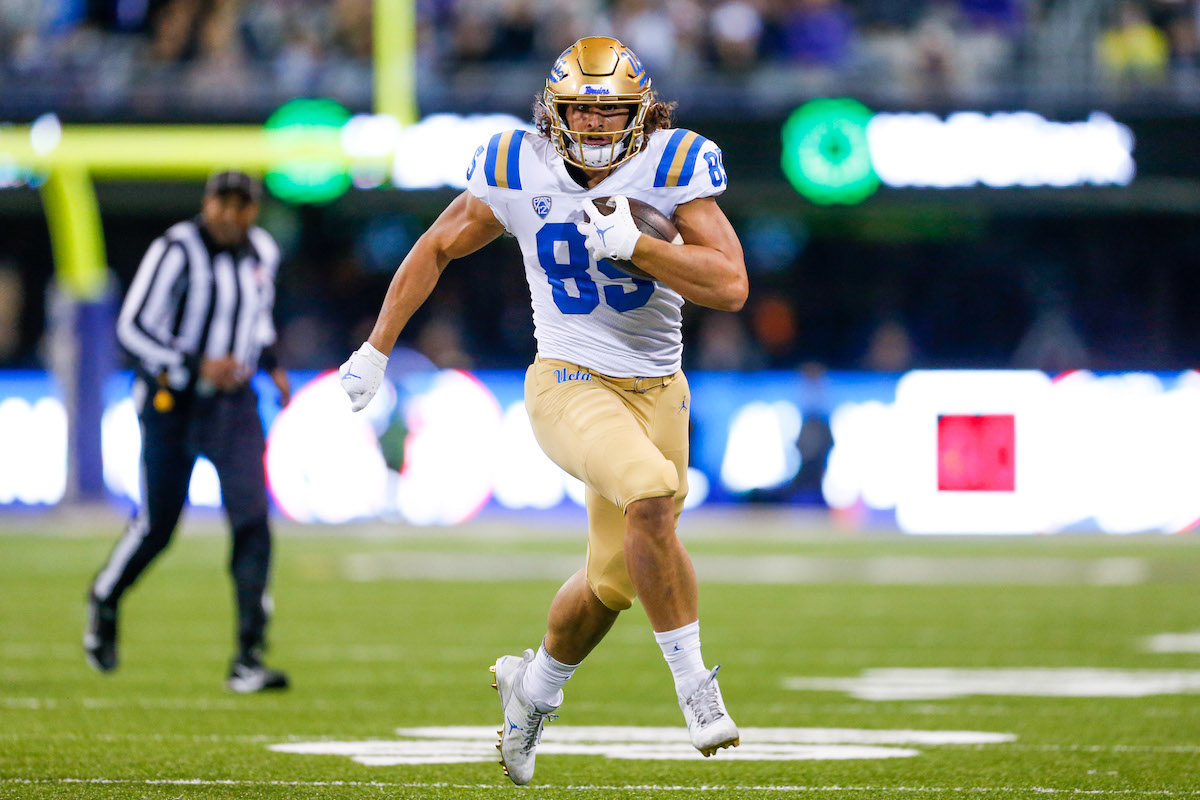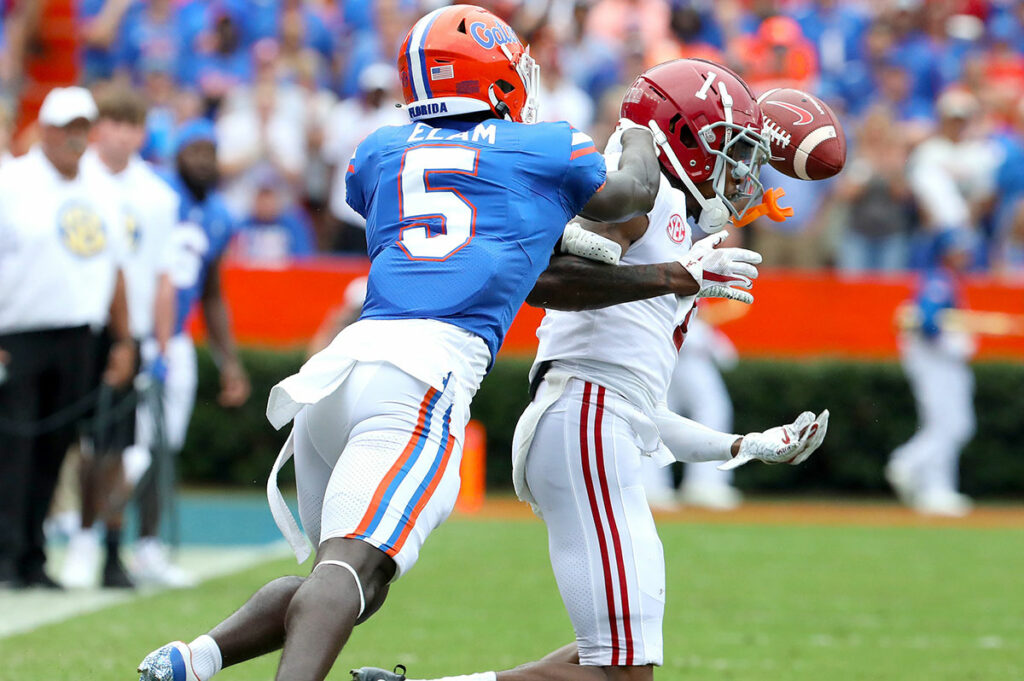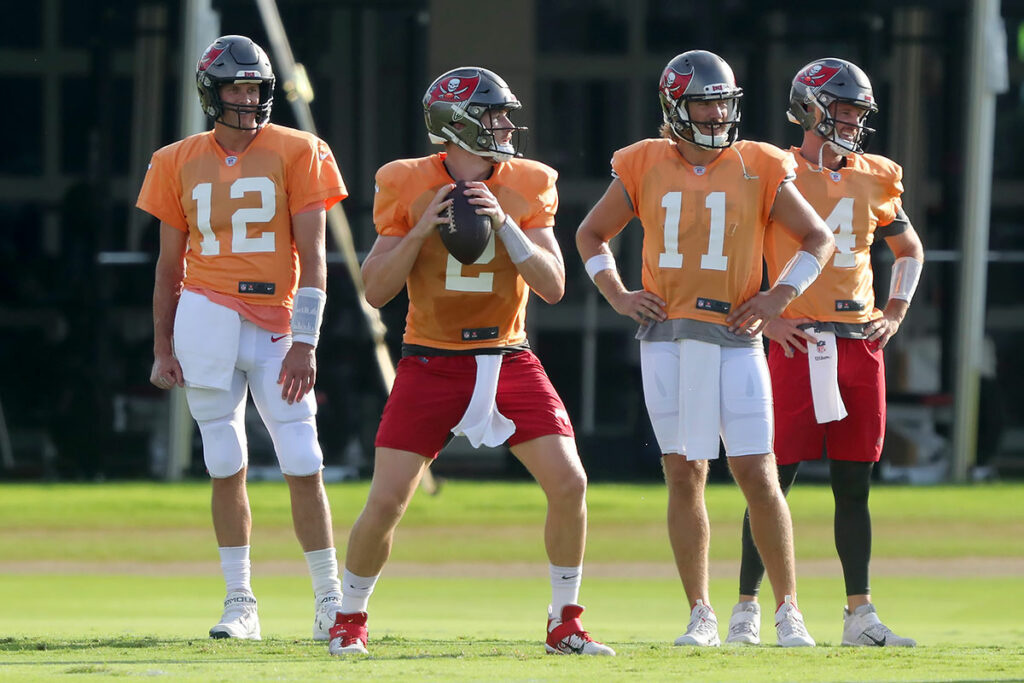This weekend, I’m releasing my 2022 NFL Draft tight end rankings and round grades. There are a few pro days left, so a couple things may still shift before the draft. But this is likely to be my final ranking of the class.
Keep in mind, my round grades are handed out in a vacuum. Each round grade is tied to the caliber of player I believe each prospect will be in the NFL. It is NOT a projection of where I believe they will or even should be selected in the actual draft. Instead it is a level of valuation I have tied to each player’s outlook for the NFL.
If you want to see my past NFL Draft tight end rankings, here they are:
2020 NFL Draft DT Rankings
2021 NFL Draft Big Board
Here are the 2022 NFL Draft tight ends I still need to complete evaluations for:
Isaiah Likely, Coastal Carolina
Grant Calcaterra, Southern Methodist
Austin Allen, Nebraska
James Mitchell, Virginia Tech
Chigozeim Okonkwo, Maryland
Cole Turner, Nevada
8. Daniel Bellinger, San Diego State (6-5, 253, 4.63)
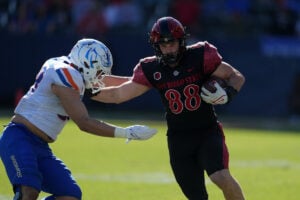
San Diego State TE Daniel Bellinger – Photo by: USA TODAY
Bellinger tested like a very good athlete at the Combine, and he has a lot of the physical traits teams want. But I just didn’t see it on tape. Whether it was falling down on routes or falling off blocks, Bellinger felt totally non-instinctive. I never watched him and thought there was an awesome athlete waiting to be unleashed with better usage in the NFL.
Instead, Bellinger looks like an ideal backup tight end to me. Decent in-line blocker, athletic enough to line up outside and block in space and very sure-handed. Of course, Bellinger was barely asked to do anything difficult as a receiver. There are hardly any downfield targets or big-time contested catches on his tape. And when he had the chance, Bellinger did very little after the catch. He’s just a guy in the NFL, but his extensive special teams experience will make him a valuable Day 3 pickup.
Year 1 Outlook: No. 3 Tight End
Year 3 Outlook: No. 2/3 Tight End
Grade: Late Fourth Round (Backup)
7. Jake Ferguson, Wisconsin (6-5, 250, 4.81)
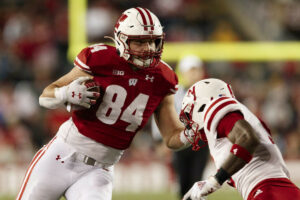
Wisconsin TE Jake Ferguson – Photo by: USA Today
Ferguson is a poor athlete who lacks ideal length and bulk for the position. So why is he even this high on the list? Because his instincts for the position are on point. Ferguson works his tail off on every rep as a blocker. He’s probably piled up more pancakes than any other tight end in the class. Yes, he’s gotta improve his balance and pad level. Sometimes Ferguson gets so aggressive he can’t stay on the block. But, man, he manhandles people at times. He planted several defenders against Penn State, including Andrew Ebiketie.
As a receiver, Ferguson is the basic Y tight end package. Reliable hands, good feel for zone coverage and excellent physicality after the catch. His entire skill set fits what most teams ask of their backup tight ends. Ferguson might have to clean a few things up first, but he should earn a part-time role if he become a more consistent blocker.
Year 1 Outlook: No. 2/3 Tight End
Year 3 Outlook: No. 2/3 Tight End
Grade: Late Fourth Round (Backup)
6. Cade Otton, Washington (6-5, 247, DNP)
I’m not sure I understand why Otton has quietly risen up boards this draft season. He’s a solid all-around tight end. There is no reason to believe Otton won’t be a good No. 2 tight end who can help a team in the NFL. But I’ll be very surprised if he’s better than the top 3-4 tight ends on my board. I don’t see that kind of ceiling for him in the NFL.

Washington TE Cade Otton – Photo by: USA TODAY
Physically and athletically, Otton is just a tier or two below the top tight ends in the class. He’s lighter with less length and minimal speed. Otton never ran the 40 during the pre-draft process due to recent surgery on his left ankle. But on tape, speed does not look like a strength. Otton struggled to get vertical throughout his career, making most of his catches underneath.
I just don’t know what Otton fans are hanging their hat on with him. He’s barely been more productive than Ruckert. Otton is a good blocker, but better than Trey McBride or Ruckert? I don’t think so. None of his measurables stand out, nor did he make splash plays on tape. He’s tough after the catch, but not anything special. And he’s worse in contested spots than the in-line tight ends ahead of him on this list. Otton needs to be able to create separation to win as a receiver, and he doesn’t do that on tape.
As a No. 2 tight end, I’m fine with Otton. He looks versatile enough to be a solid 12 personnel option for an NFL team. Reliability shouldn’t be an issue, and he can help in the run game. Beyond that, I think the expectations out there are beyond what he’s likely to reach.
Year 1 Outlook: No. 2/3 Tight End
Year 3 Outlook: Good No. 2 Tight End
Grade: Early Fourth Round (Backup)
5. Charlie Kolar, Iowa State (6-6, 252, 4.62)
Kolar made a living on contested catches at Iowa State, but that doesn’t mean he can’t separate. There is a lot of consistent nuance missing as a route runner, but Kolar is a good athlete. His testing confirmed as much. Why didn’t his athleticism show up more often on tape? Why was his area of impact typically so close to the line of scrimmage?
I think Kolar can be something more in the NFL as a receiver. He was frequently targeted at Iowa State, but his splashiest plays were combat catches. Because Kolar is an average blocker at best, his NFL ceiling will be determined by how much he can develop as a route runner. But even if he doesn’t, the 23-year old’s skill set will still be valuable in the passing game. Ball skills like Kolar’s are a huge asset at tight end, especially in the red zone. It’s no surprise Kolar churned out 23 touchdowns in 49 games as a Cyclone.
Kolar probably needs to be paired with a quality blocker in the NFL, sharing playing time. He might never be an 80-percent-of-snaps starter, but Kolar should make solid contributions as a receiver.
Year 1 Outlook: No. 2/3 Tight End
Year 3 Outlook: Solid Rotational Starter
Grade: Late 3rd Round (Backup)
4. Jeremy Ruckert, Ohio State (6-5, 252, DNP)
If you told me that in a few years Ruckert would be the best tight end in this class, I wouldn’t be surprised. His tape shows a well-rounded player and a good athlete who simply didn’t receive the opportunity to do much in college. Playing in an offense with three first-round wide receivers will do that to you. But Ruckert doesn’t have many obvious weaknesses on tape. He could have elevated his stock considerably during the pre-draft process. But a foot injury during Senior Bowl week killed his ability to participate in Mobile and at the Combine.
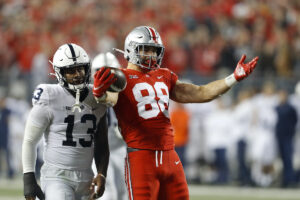
Ohio State TE Jeremy Ruckert – Photo by: USA TODAY
What stands out immediately about Ruckert is his frame. He is 6-foot-5, 252 pounds of muscle and it shows in the run game. Ruckert was frequently used as blocker, in-line, flexed out and on the move. He’s pro-ready in that regard, but needs to rein in his aggressiveness some. Ruckert can crush defenders, but will sometimes get too anxious and fall off blocks. If he brushes up his technique, the senior could be one of the better blocking tight ends in the league.
The biggest concern with Ruckert isn’t what he’s bad at on tape. It’s what we don’t know if he’s good at on tape because he never got to do it. Hardly ever was Ruckert asked to run downfield routes, leaving his speed as somewhat of an unknown. However, during two long plays by other Buckeyes’ skill players, Ruckert raced downfield to get in on the action as a blocker. I think his speed is better than average for an NFL tight end. He just hardly got a chance to show it.
That’s the story of Ruckert’s college career as a receiver. The 2021 season was the first time he ever received more than 17 targets in a season. But the New York native still notched just 39 targets, reeling in 26 catches for 309 yards and three touchdowns. On 54 college catches, Ruckert scored 12 times. In the red zone, he’s proven to be effective. But between the 20s, there is a lot we still need to learn. I’ll bet on his upside, strong hands and toughness after the catch in the NFL.
Year 1 Outlook: No. 2 Tight End
Year 3 Outlook: Solid Starter
Grade: Early Third Round (Solid Starter)
3. Jelani Woods, Virginia (6-7, 253, 4.61)
Woods has always been a massive target, but he was seldom utilized in the passing game until the 2021 season. After transferring from Oklahoma State to Virginia, Woods erupted as a receiver. The senior caught 44 passes for 598 yards and eight touchdowns for the Cavaliers. Then he dominated the East-West Shrine Bowl before heading to the NFL Scouting Combine to steal the show. Woods ran 4.61 with an 82-inch wingspan, then crushed the jumps and agility drills at his pro day. When it comes to winning the pre-draft process, Woods is the poster child in this class.
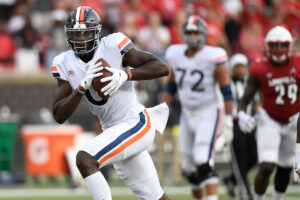
Virginia TE Jelani Woods – Photo by: USA TODAY
But the tape is encouraging, too. Woods can stretch the field, make catches outside his frame and excels at boxing out defenders for tough grabs. Per PFF, Woods caught over 61 percent of his contested opportunities this season. With his size, strength and length, there’s no reason to think that won’t translate to the NFL. Remember, tight ends are not typically covered by the defenders with the best ball skills. Woods should be a catch-point monster in the NFL.
Then there’s his route-running. While Woods is a little bit stiff and more of a build-up speed runner than a quick accelerator, he flashes some real nuance in his routes. He’ll jab step and break the other way, or stay vertical and break off his routes at the last instant. Yes, he doesn’t have the quickest change of direction. But Woods is so big and fast that he is still a tough cover. And when defenders do stick to him, he typically makes the grab anyway.
Can he keep developing as a blocker? He has all the physical traits and the experience, but his technique and pad level aren’t good enough right now. Woods also has to clean up the drops and won’t be a huge threat after the catch. However, he can help a team in need of a movable tight end with an improving all-around game.
Year 1 Outlook: Offensive Weapon/No. 2 Tight End
Year 3 Outlook: Solid Starter
Grade: Early Third Round (Solid Starter)
2. Trey McBride, Colorado State (6-4, 246, 4.56)
McBride is the most capable classic ‘Y’ tight end in the 2022 draft. He’s sure-handed, he adjusts very well to the football downfield and his blocking ability is top-notch. Sure, McBride isn’t the biggest or strongest tight end, but his technique and ferocity in the trenches is very good. He can play early snaps as a starter in the NFL, which is rare for a college tight end.

Colorado State TE Trey McBride – Photo by: USA Today
Having said that, there are two significant concerns I have with McBride. First, he’s not a very good route runner right now. Everything is rounded off, and there is very little nuance at the top of his route. He plays at one speed, which allows defenders to mirror him in man coverage too easily. McBride must learn to vary his speeds and become more deceptive as a route runner. He has enough athleticism to improve in this area.
My second concern with McBride is how poor he is after the catch. This is a bonus for a tight end, but with his athleticism, McBride should be better in this area. On 91 catches last year, PFF credited the senior with forcing just five missed tackles. That’s the same amount of missed tackles Ruckert forced on just 26 catches. Post-catch production probably won’t improve for McBride against better tacklers and athletes. It’s a weakness you’ll likely have to live with in the NFL.
Still, McBride’s ball skills and contested catch ability is too impressive to overthink. He also makes plays in the vertical passing game and can block. There probably isn’t an elite ceiling for McBride, but he should be a sure-fire starter in the NFL.
Year 1 Outlook: Solid Starter
Year 3 Outlook: Solid Starter
Grade: Early Third Round (Solid Starter)
1. Greg Dulcich, UCLA (6-4, 243, 4.69)
If my offense isn’t looking for a true ‘Y’ tight end that can play in-line and block, I would draft Dulcich first in this group. To me, he’s the best offensive weapon amidst the 2022 tight end class. In a unique situation, he actually scored better as a receiver on my grading scale than McBride. But because Dulcich is worse than McBride as a blocker, the two were very close in total points. A 4.69 Combine 40-yard dash hurt Dulcich’s grade, too. But I simply like him the most on tape.
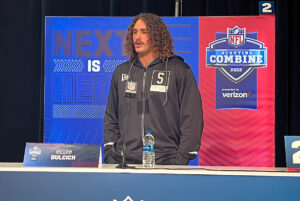
UCLA TE Greg Dulcich – Photo by: Pewter Report
On tape, I thought Dulcich was easily the best route-running tight end in the class. He comes out of his breaks without losing speed, even showing some craftiness to separate at the top of the route. Although his Combine 40 was just okay, Dulcich’s speed looks like a real strength on tape. He consistently gets separation, which resulted in very few contested catch situations last year. As a result, Dulcich doesn’t have all the tough grabs on tape that McBride does. But that’s because he’s operating in space more often, thanks to his route-running ability.
Dulcich gets impressive reviews as a person from people at UCLA as well. Time in the weight room added critical mass to his frame. But Dulcich is often playing a big slot receiver in UCLA’s offense. Dulcich has enough in-line ability and experience to be able to play there in the NFL. But he’s not the blocker McBride, Ruckert and others in the class are. Teams will need to keep that in mind when drafting him.
Still, the strengths out-weigh the weaknesses if the scheme fit is right. Dulcich catches the ball well, makes plays down the field and is a factor after the catch. He may not have elite traits, but he has good enough ones to be a good starting tight end in a league starving for them. Use him the right way, and you won’t regret the pick.
Year 1 Outlook: Offensive Weapon
Year 3 Outlook: Good Starter
Grade: Late Second Round (Good Starter)

